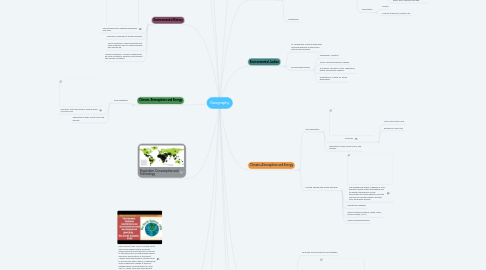
1. Ecology
1.1. Cultural
1.1.1. Focuses on a smaller scale.
1.1.2. Questions transfer of modern techniques to local and native contexts.
1.2. Political
1.2.1. Critiques Cultural Ecology and politicizes environmental issues.
1.2.2. Decision making structures, hierarchies of power.
2. Hazards
2.1. Natural Hazard
2.1.1. Different things to different communities or people
2.2. Technological Hazards
2.2.1. Industrial Pollution, Nuclear Radiation, Toxic Wastes, Dam Failures, etc.
2.3. Risk
2.3.1. Between Hazards and Society
2.3.2. Risk Perception
2.3.2.1. How do we prepare + what prompts us to action.
3. Environmental History
3.1. How humans have modified landscapes over time.
3.2. Changes in ideas about the environment.
3.3. Social Darwinism: People are subject to same Darwinian laws of nature as plants and animals are.
3.4. Cultural Possibilism: Culture is determined by social conditions, whereas, Environment sets certain constraint.
4. Climate, Atmosphere and Energy
4.1. Acid Deposition
4.1.1. Acid Rain: Nitric and sulfuric acids burning off fossil fuels.
4.1.2. Deposition in lakes, forest floors and humans.
5. Population, Consumption and Technology
6. Policies
6.1. Earth Summit 1992: The UN sought out to help Governments rethink economic development and find ways to put an end to the destruction of irreplaceable natural resources and pollution of the planet. Leaders were persuaded by citizens to go to Rio and join other nations in making the difficult decisions needed to ensure a healthy planet for generations to come. The US, Japan, India and China did not meet emission reductions.
6.2. Kyoto Protocol: International agreement that commits its Parties by setting internationally binding emission reduction targets.
6.3. Copenhagen Accord 2009: "recognizes" the scientific case for keeping temperature rises to no more than 2 degrees Celsius. but does not contain commitments to emissions reductions to achieve that goal. It is an agreement that is not legally binding.
6.4. Efforts at Conservation
6.4.1. Endangered Species Act- 1973 FWS and NOAA
6.4.2. Convention on Biological Diversity (CBD)
6.4.3. Habitat Conservation Plans (HCP's)
6.4.4. More attentions to wetlands, grasslands, marine and aquatic environments. Exp. coral reefs and mangroves.
7. Elephant Habitats:
7.1. Elephant habitats have conflicts with local communities. For example , humans are impacted by ("Elephants in the Coffee"). Elephants that get into coffee plantations and trample coffee trees. On the other hand, in order to conserve elephant species, conservationists have improved and protected Asian elephant ranges, protected elephants from human conflict such as that with coffee farms,protection from the ivory and meat trade, and ironically enough, protection from black ivory coffee production.
8. Human Environment Geography
8.1. Developed/developing worlds.
8.2. Relationships between human and environment.
8.3. Sensitive to scale.
8.3.1. Small Scale Map: has less detail. Zoomed out over a large area.
8.3.1.1. Small Scale Map Vs. Large Scale Map
8.3.2. Large Scale Map: more detail and zoomed in on a smaller region.
9. Physical Geography
9.1. Human Geography
9.1.1. Examination of human and social existence
9.1.1.1. Ecocentric Approach
9.1.1.1.1. Importance to Non-human nature
9.1.1.1.2. Non-human nature has "agency"
9.1.1.1.3. Post- Humanism
9.1.1.2. Constructivist Approach
9.1.1.2.1. Nature has never been natural.
9.1.1.2.2. Consider a "natural" event on you/ your family. Exp: California Drought
9.1.1.3. Socionature
9.1.1.3.1. Holistic
9.1.1.3.2. Involves Economics, politics, etc.
9.2. Climatology
10. Environmental Justice
10.1. EJ Perspective: Political movement involving research on the human environment dilemma.
10.2. Environmental Equity
10.2.1. Geographic: Location
10.2.2. Social: Influence decision-making
10.2.3. Procedural: Fairness of rules, regulations, power and decision making.
10.2.4. Generational: Justice for future generations.
11. Climate, Atmosphere and Energy
11.1. Acid Deposition
11.1.1. Acid Rain
11.1.1.1. Nitric and Sulfuric Acid
11.1.1.2. Burning of fossil fuels
11.1.2. Deposition in lakes, forest floors, and humans.
11.2. Climate Change and Global Warming
11.2.1. The Greenhouse Effect: Trapping of sun's warmth in Earths lower atmosphere due to greater transparency of the atmosphere to visible radiation from the sun than to infrared radiation emitted from the planets surface.
11.2.2. Climate and Weather
11.2.3. Carbon Dioxide, Methane, Water Vapor, Nitrous Oxides, CFC's
11.2.4. Carbon Dioxide Emissions
12. Agriculture and Food Systems
12.1. Food and Oil prices tend to rise together
12.2. Systems:
12.2.1. Extensive Agricultural Systems: Limited labor or energy input.
12.2.2. Intensification: More labor and energy lead to higher yields.
12.2.3. Intensive Agricultural Systems: Low external inputs (rely on labor/ organic fertilizers). High external inputs (rely on inorganic fertilizers, pesticides and mechanization.

